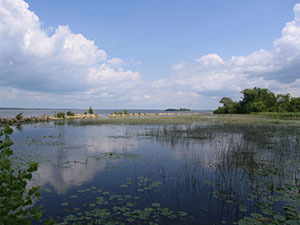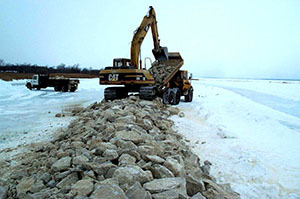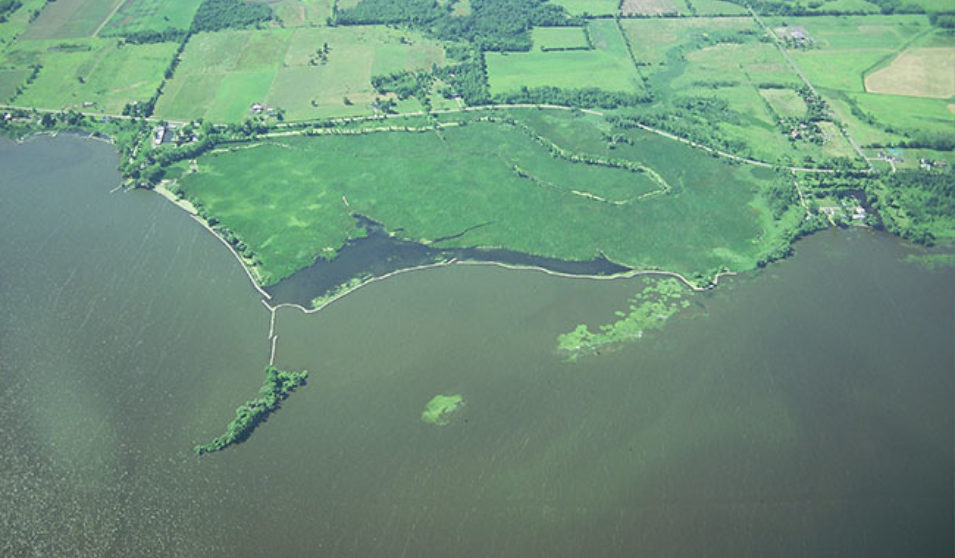The Winnebago System consists of Lake Winnebago, Butte des Morts, Winneconne and Poygan. The system contains approximately 167,000 surface acres, which represents 17% of Wisconsin’s surface water. Over half of this surface water is located in Winnebago County alone. The upper river lakes (Butte des Morts, Poygan, and Winneconne) were once large, fertile, riverine marshes supporting dense emergent and submergent plant communities.
In the 1850’s, dams were constructed in Neenah and Menasha for the improvement of commercial navigation that resulted in an increase of 2-3 feet in water levels. Impoundment of the system changed the upper river lakes from a river marsh ecosystem to a large, nutrient rich, turbid open water lake system.
Wave action, especially during high water years, continues to erode shorelines and adjacent wetlands. Changes in water levels, increased sediment delivery and wave action have all contributed to the loss of tens of thousands of hectares of wetland habitat. The upper river lakes (Butte des Morts, Poygan, and Winneconne) were once large, fertile, riverine marshes supporting dense emergent and submergent plant communities.
In the 1850’s, dams were constructed in Neenah and Menasha for the improvement of commercial navigation that resulted in an increase of 2-3 feet in water levels. Impoundment of the system changed the upper river lakes from a river marsh ecosystem to a large, nutrient rich, turbid open water lake system.
Wave action, especially during high water years, continues to erode shorelines and adjacent wetlands. Changes in water levels, increased sediment delivery and wave action have all contributed to the loss of tens of thousands of hectares of wetland habitat.

In 1998, the Winnebago County Land & Water Conservation Department (LWCD) conducted a shoreline/streambank inventory and found that over 225,000 feet of shoreline/streambank needed some type of protection.
The lake adjacent wetlands inventoried had lateral recession rates ranging from 1 foot to an alarming 15 feet per year. In some cases, landowners are losing more than 5 acres of their land to the Winnebago System each year. These high erosion rates contribute large amounts of sediment and phosphorus towards the lakes which can cause pollution and algae blooms. These lake adjacent wetlands are some of the most important marshes left in the Winnebago System.
Since 1998, the Winnebago County LWCD has been successfully installing off-shore breakwaters to address the ongoing loss of these fragile lake adjacent wetlands. Breakwaters are designed off-shore in open water and built to protect shorelines from excessive erosion, while providing “quiet water” behind the structure for restoration and protection of critical habitat.
By leaving a space behind the structure, we are creating “quiet water” inside of the breakwater. Shallow emergent and submergent plants are then able to establish and stabilize themselves into the sediment with their root systems. Without this separation behind the structure, the critical littoral zone would be lost. Breakwaters assist in breaking the wind driven wave before it has the chance to reach the shoreline. Not only does this protect the existing shoreline it also aids in the retention of sediment behind the structure.

Our department works closely with the WI DNR throughout the design process to ensure support for the installation of these projects. Typical breakwater designs have a 2-foot top, 2:1 side slopes, a design height of 2 feet above the ordinary high water mark and are located in 1-4 feet of water to be the most cost effective.
The breakwaters are designed with shot rock ranging from 6”-24” in size with a small percentage of fines. The size range allows the rock to interlock together making it able to withstand the high energy found on the Winnebago System. A non-woven geotextile is always required and sediment readings are conducted to provide guidance for settling of the structure into the lake bottom.
All breakwaters have openings or breaks in the structures to allow for fish and wildlife access, human access, and limited water circulation. Breakwaters are typically installed during the winter months once the ice thickness reaches close to 2 feet in order for supporting the heavy loads of the equipment used to construct these unique projects.
To date, the Winnebago County LWCD has designed and installed 27 breakwaters on the Winnebago System for a total length of approximately 6 miles. This has resulted in pollutant reductions of over 4,400 tons of sediment and over 6,600 lbs. of phosphorus annually. These breakwaters currently protect 753.5 acres of lake adjacent wetland shoreline from further erosion while restoring over 142 acres of new wetlands.

